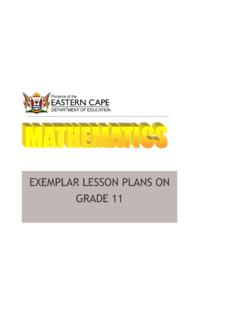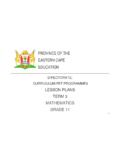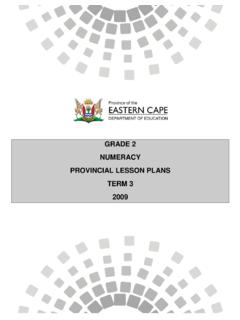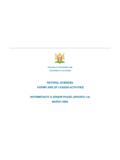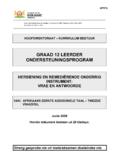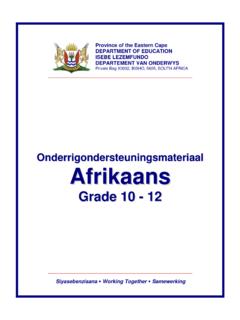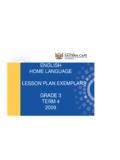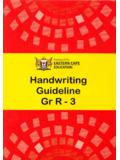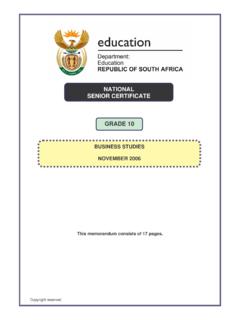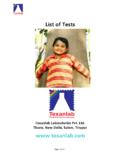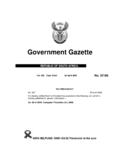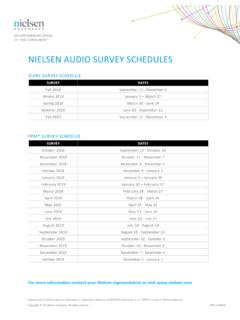Transcription of FINAL grade r guidelines Harrys 7 April 2008 - Primex
1 Foreword grade R is currently offered at Public Schools, Community-based sites and Stand alone sites. All grade R educators are expected to assess learners, draw up Work Schedules, Lesson Plans as well as organize and manage a grade R classroom. Reports from District Officials who monitor grade R indicate that substantial support is needed in these areas. This Guideline Document has been developed to support effective classroom implementation and standardize grade R in the Province. It is the task of grade R educators to expose their learners to a variety of activities and learning experiences to ensure that learners reach their full potential.
2 A high quality grade R programme and commitment from educators will lay the foundation for improved Literacy, Numeracy and Life Skills levels in the Province. grade R educators are encouraged to use this guide document in conjunction with textbooks in respect of the planning, teaching and assessment process. The document is aligned to the following guidelines : Provincial Literacy Strategy, Learner Attainment Targets and Provincial Assessment Document. We hope that this Guideline will provide the necessary clarity and guidance needed to manage grade R more effectively to ensure quality teaching and learning.
3 Dr F Peters Director: Curriculum ECD & GET Programmes TABLE OF CONTENTS PAGE INTRODUCTION SECTION 1 : FREQUENTLY ASKED QUESTIONS 1 What is meant by grade R and how does it differ from grade 1? 1 What is the admission age for a grade R learner? 1 What is meant by pre- grade R learners? 2 What is the career path for the unqualified and under-qualified grade R practitioner at a public school? 2 Which Documents should be in the school? 2 Which Documents/files should a grade R educator have in her classroom? 3 What School Calendar should be followed for grade R? 3 What is the duration of the school day?
4 3 Should grade R learners wear school uniform? 4 Why is the noise level coming from the grade R class higher than that from the rest of the Foundation Phase? 4 What should the grade curriculum at public schools, free standing pre-schools and community sites address? 4 SECTION 2 : THE grade R CLASSROOM, PLAYGROUND AND DAILY TIMETABLE 7 The Classroom Layout: 7 grade 1 Classroom compared to the grade R Classroom 7 The grade R Classroom 8 Arranging the Classroom 9 The Outdoor Play Area 14 The Daily Programme 16 Managing the Classroom: 18 Adult Guided Activities: Whole Class Activities 18 Small Group Activities 18 Free Play 20 Learners with Barriers to Learning 20 SECTION 3.
5 THE THREE LEARNING PROGRAMMES 23 EXPLANATION OF THE THREE LEARNING PROGRAMMES IN FOUNDATION PHASE FROM A grade R PERSPECTIVE The Literacy Learning Programme 23 The Numeracy Learning Programme 36 The Life Skills Learning Programme 39 The 5 other Learning Areas 40 PLANNING THE THREE LEARNING PROGRAMMES FOR grade R 45 Work Schedule 5 day Lesson Plan 48 Ideas of Activities for the Week 50 Discussion Points 53 Music Lesson 54 Movement Lesson 55 grade R Lesson Plans 56 SECTION 4: ASSESSMENT 58 The Assessment Cycle 59 Assessment Tasks 60 Observation in the Foundation Phase 61 Formal Assessment Tasks 61 Continuous Assessment (CASS) in grade R 62 Coding for Assessment in grade R 63 Forms of Assessment 63 Assessment Tools 63 Assessment Plans 66 Formal Assessment Tasks: Literacy 67 Annual Assessment Programme for LAT grade R 68 Assessment Tasks per term 69 Record Sheet Numeracy per term 70 Annual Schedule for Numeracy per year 71 A Checklist for grade R Educator / Practitioner 72 Acknowledgements` 77 1 SECTION 1: FREQUENTLY ASKED QUESTIONS QUESTION.
6 WHAT IS MEANT BY grade R AND HOW DOES IT DIFFER FROM A grade 1 CLASS? The term grade R will be used uniformly to mean the year before entering grade 1. This term will replace all current terms in use such as grade O, Pre-primary class etc. The National Policy: Education White Paper 5 (21 October 2001) on Early Childhood Development promulgated in terms of the National Education Policy Act (Act 27 of 1996) requires that by 2010 most of the five turning six year olds would be accommodated within primary school-based reception year programmes (paragraph ).
7 By 2010 all learners entering grade 1 will have access to a grade R Programme. The National Curriculum Statement starts from grade R and thus grade R forms an integral part of the Foundation Phase and should not be isolated. There are however differences which make grade R unique from the rest of the Foundation Phase (Grades 1 to 3) and these are: grade R grade 1 Not yet compulsory Compulsory in the year the child turns 7 Follow a Daily Programme with : Free play activities (Inside and/or Outside ) Routine Activities Educator Guided Activities in: Literacy Numeracy Life Skills Follow a Time Table: Learning Programmes: Literacy Numeracy Life Skills Classroom Layout: Informal corners and open-plan areas (no desks in rows - just groups of tables and chairs) More structured classroom layout with desks QUESTION.
8 WHAT IS THE ADMISSION AGE FOR A grade R LEARNER? Act No 50 of 2002: Education Laws Amendment Act 2002, Section 5 of the South African Schools Act, 1996 was amended by the substitution for subsection (4) of the following subsection: The admission of a learner to a public school: (i) grade R is age four turning five by 30 June in the year of admission (ii) grade 1 is age five turning six by 30 June in the year of admission A parent can send their child to grade 1 at the age six turning seven. (Media Statement by National Department of Education 2 August 2004). When learners are admitted to a grade R class great care should be taken to: ensure that learners are of the correct age ensure that Community-based sites do not send learners to a grade R class at too young an age ensure that Public Schools do not accept learners to a grade R class at too young an age ensure that the submission of a birth certificate and immunization record card as proof of the child s age be submitted (required for admission -a copy to be kept on file.)
9 The grade R educator will thus have to work out Work Schedules and Lesson Plans for learners turning five/six years old in her/his class. 2 QUESTION: WHAT IS MEANT BY PRE- grade R LEARNERS? Pre- grade R learners Learners younger than 4 years and 6 months old. QUESTION: WHAT IS THE CAREER PATH FOR THE UNQUALIFIED AND UNDER-QUALIFIED grade R PRACTITIONER AT A PUBLIC SCHOOL? Under-qualified grade R practitioners attached to schools need to undergo / receive accredited SAQA NQF Level 4 ECD training (REQV 10 ECD). Practitioners are encouraged to aim to improve their qualification to REQV 13.
10 NQF Level 4 ECD NQF Level 5 Level 6 Upgrading of Unqualified or Under-qualified Educators ( See Page 6 South African Council for Educator Document or consult Professional Development and Support Sub-Directorate Head Office DoE Zwelitsha for Further Information ) Qualification Who may apply New REQV Classification upon completion National Professional Diploma in Education 360 Credits 3 years Practitioners in schooling with qualifications classified at least at NQF level 4 in any other subfield on NSB 05 ( Early Childhood Development ) REQV 13 QUESTION: WHICH DOCUMENTS SHOULD BE IN THE SCHOOL? National Curriculum Statement Policy Documents Gr R to 9 Education White Paper 5 on ECD (21 October 2001) Education White Paper 6: Special Needs Education (July 2001) The Admission Age Policy: No 84 of 1996 South African Schools Act Amendment of Section 5: The Admission Age of Learners into Public Schools National Education Policy Act 27 of 1996: Language in Education Policy National Education Policy Act 1996: National Policy on HIV/AIDS for learners and practitioners Government Gazette on Assessment February 2007 Edition 29626 Learner Profiles with.
